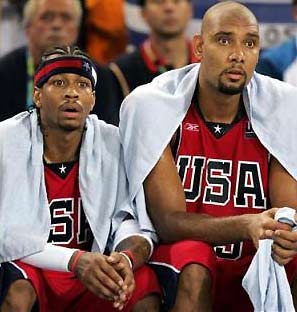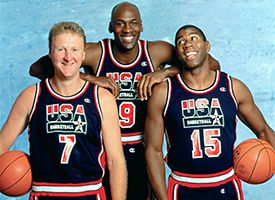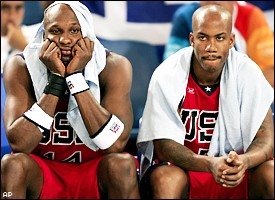
In 1992, the United States basketball team, known around the world as the Dream Team, won by an average of 44 points per game en route to a gold medal at the Barcelona Summer Olympics. Twelve years later in 2004, the US team was upset and embarrassed, settling for a bronze medal in Athens. Now, in 2008, the US team will look to repeat what the ’92, ‘96’, and ’00 teams did – win the gold medal.
But it won’t be easy. Teams like Italy, Argentina, and Lithuania have shown they are world-class teams. While they don’t have the individual talent the US team possesses, they play like a team – something the 2004 US ‘stink team’ did not do.
In order to win the 2008 Olympics, the US team will have to return to their roots. With five players on the 2004 team returning for this summer’s Olympics, the Americans will have to change their game to be less like the 2004 team, and more like the Dream Team.
To see if the US has what it takes to make it all the way, lets compare the famed Dream Team, the doomed 2004 team, and the current Olympic squad.
Results
Dream Team: Gold medal, 8-0 record, won by average of 44 points
Stink team: Bronze medal, 5-3 record, won by average of 5 points
2008 team: In qualifying, 10-0 record, won by average of 40 points
Verdict: The US team has showed Dream Team-esque dominance through qualifying, but that doesn’t mean much. The ‘stink team’ won their qualifying games by an average of 31 points, but couldn’t replicate those results when it mattered in the Olympics.
Hall of Fame Factor
DT: Of the 12 players on the roster, five are already in the Hall of Fame and another six are certain to be when they become eligible. Never have so many great players been on the team at one time – ten of the 12 players were named to the 50 Greatest Players of All Time list in 1996.

ST: Individual talent couldn’t be to blame for the ’04 team. With arguably the greatest scoring point guard of all time in Allen Iverson and arguably the greatest power forward of all time in Tim Duncan, the team featured four other players who are locks for the Hall of Fame when their careers come to an end.
2008: The 2008 team is loaded with Hall of Fame-caliber players. Apart from Michael Redd, Chris Bosh, Carlos Boozer, and Tayshaun Prince, the remaining eight players have had or are showing potential for Hall of Fame careers.
Verdict: The Americans have an all-star cast of players for this year’s Olympics. But as the 2004 games showed, it doesn’t come down to individual talent.
Guards
DT: Michael Jordan, Magic Johnson, Clyde Drexler, John Stockton. Two prolific passers in Johnson and Stockton, one prolific scorer in Jordan, and one all-around stud in Drexler. They balanced each other out perfectly, and no matter which two were on the court, the US team was in good hands.
ST: Allen Iverson, Stephon Marbury, Dwayne Wade. Marbury was a cancer to the US team. In eight games, he averaged only 4 assists per game. Iverson and Wade were just as reluctant to share the ball. How can a football team expect to win with two center midfielders that don’t pass the ball? Basketball is the same way, and selecting these three to direct the US offense was a step in the wrong direction.
2008: Jason Kidd, Chris Paul, Deron Williams, Michael Redd, Wade, Kobe Bryant. With six players selected to play two positions, the Americans are in no shortage of guards. The three point guards are pass-first types of players, while the three shooting guards are a mix of a jump shooter (Redd), a slasher (Wade), and an all-around killer (Bryant).
Verdict: Kidd may be 38-0 in international competition and Paul may be the best point guard in the game, but the man running this offense should be Williams. The teams the US will face feature taller, more physical point guards. Paul is tiny and Kidd is a liability on the defensive end, but Williams has the physical stature to withstand the blows that come with international competition. Wade made the team again even though he can’t really pass the ball and he can’t take jump shots. But in bringing Redd, they are solving the problem they had in 2004 by not bringing any pure shooters. And while the trio of true point guards is a huge improvement over the 2004 team, they don’t even compare to the talent and balance the Dream Team showed.


Forwards
DT: Charles Barkley, Karl Malone, Larry Bird, Chris Mullin, Scottie Pippen, Christian Laettner. The perfect balance of offensive tenacity (Barkley), defensive prowess (Pippen), inside dominance (Malone), veteran leadership (Bird), three-point accuracy (Mullin) and youth (Laettner). You could not have selected six better guys to send to Barcelona.
ST: Carmelo Anthony, Richard Jefferson, Shawn Marion, Lamar Odom, Lebron James, Carlos Boozer, Amare Stoudemire. What a mess. Stoudemire and Anthony were utterly useless, combining to average a whopping 5.2 ppg. Jefferson was a forgettable selection, shooting 32% from the field. Odom shot an abysmal 52% from the free-throw line. The one bright spot was Boozer, who was able to play at his natural position of power forward (at Tim Duncan’s expense).
2008: Anthony, James, Tayshaun Prince. Anthony is expected to be the starting power forward. Yes, you read that correctly. Anthony, one of the NBA’s best shooters from outside the paint, is going to be starting in one of the most physical positions on the basketball court. Does manager Jerry Colangelo not want to win any offensive rebounds? James will start at small forward, which is his rightful position. Prince was the surprise selection, most likely picked for defensive purposes.
Verdict: These three players average under seven rebounds per game. If Anthony is truly going to play power forward, the Americans will have a tough time controlling the boards. This is going to put a lot of stress and added responsibility on whoever is playing center for Team USA.
Center
DT: David Robsinson, Patrick Ewing. What a novel idea – having two 7-footers playing center. Robinson and Ewing split time right down the middle, both averaging 9 ppg in the competition and combining for half of the team’s blocks. Having two true centers allowed Malone and Barkley to bang bodies down low while allowing Mullen and Pippen to get open for outside jumpers – the perfect frontcourt combination.

ST: Tim Duncan, Emeka Okofor. Duncan isn’t a center. Okafor isn’t a center. What the hell were these two doing playing center? Hell, Okafor wasn’t even in the NBA yet! Poor Duncan had so much weight to pull in 2004, he quickly declined an offer to play in these 2008 games. While Duncan did fine on the offensive end, being the only big man led Duncan into serious foul trouble. And with Duncan out of the game, the team got pounded on the boards, and you can’t expect to win a game if you can’t rebound.
2008: Dwight Howard, Chris Bosh, Boozer. Did US officials not learn anything from 2004? Howard is the only true center, but even then, he’s undersized. Boozer and Bosh are excellent players in the power forward slot, but when asked to play center, there is no way they will be utilised to their fullest playing potentials.
Verdict: None of the players on the roster are over 6’11”, meaning rebounds may be hard to come by in Beijing. For the US team to be successful, their big men have to stay out of foul trouble. But with a five-foul limit instead of the NBA standard six, this may be easier said than done.
Final Verdict
In 2004, the US team failed to bring a true point guard, a pure shooter, and a true center to Athens. They paid the price greatly. This year, they have certainly made up for two of those problems. But they still lack a 7-footer. In fact, the last time the US team brought a 7-footer to the Olympics, Jon Lovitz was still a household name.
If the US team wants to win, they have to work together. Take a look at these scoring averages at the last four Olympic games:
1992: 10 players averaged over 8 ppg
1996: 9 players averaged over 8 ppg
2000: 6 players averaged over 8 ppg
2004: 5 players averaged over 8 ppg
With guys like Kidd, Paul, and Williams distributing the ball, everyone will have an opportunity to score. But scoring isn’t what the US team needs to worry about. FIBA competition is especially physical, and if the Americans want to win, they have to be able to bang down low without getting into foul trouble. And with young guys like Howard and Bosh who don’t have a lot of international experience, I don’t see the US team going undefeated like the Dream Team did in 1992. But I also don’t see them settling for a bronze medal like they did in 2004.
Prediction
Gold medal. They may lose a game or two, but when they get to the semi-finals, they won’t come up short again. And when they make it to the championship game, they will know exactly what to do.


